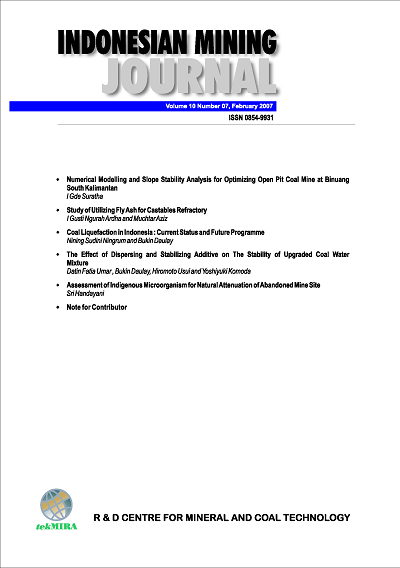ASSESSMENT OF INDIGENOUS MICROORGANISM FOR NATURAL ATTENUATION OF ABANDONED MINE SITE
DOI:
https://doi.org/10.30556/imj.Vol10.No1.2007.630Keywords:
Abandoned mine site, indigenous microorganism, natural attenuation, bioremediation, microcosm studyAbstract
Soil samples taken from an abandoned gold mine site in East Kalimantan exhibited high concentra- tion of manganese (9,830-13,190 mg/L), iron (340-8,060 mg/L) and arsenic (160-510 mg/L). However, the indigenous microbial population was found to be present at high level (> 107 CFU/g), indicated that the site matrix did not appear to be inhibitory and relatively favorable to microbial growth. Furthermore, laboratory microcosm studies showed that the indigenous microorganisms possessed a considerable bioremoval potential of contaminated metal at the site. Those results suggested that natural attenua- tion of metal bioremoval would occur under present site condition.
References
Anderson, B.N., 1995. Recent development in contaminated site investigation-the assess- ment of indigenous microflora and natural at- tenuation, In : Bioremediation: The Tokyo ’94 Workshop, OECD Documents, pp 189-193.
Baker, K.H., and D.S. Herson, 2004. Bioremediation, Mc Graw-Hill, New York, pp 133 – 135.
Balba, M.T., N. Al-Awadhi and R. Al-Daher. 1998. Bioremediation of contaminated soil:Microbial methods for feasibility assessment and field evaluation. J.Microbiol 32, pp 155-164.
Diels, L. 1997. Heavy metal bioremediation of soil, In: Bioremediation protocols, Eds. D. Sheehan, Humana Press, New Jersey, pp 284-285.
Lamar, R.T., L.M. Main, D.M. Dietrich and J.A. Glaser, 1999. Screening of fungi for soil remediation potential, In: D.C. Andriano et al. (Eds), Bioremediation of contaminated soils, pp 437-456. Soil Science Society of America Inc., Madison, Winconsin.
Morra, M.J. 2006. Bioremediation in soil: Influence of soil properties on inorganic contaminant and bacteria, In: Bioremediation principles and application, Eds. R.L. Crawford and D.L. Crawford, Cambridge University Press, pp 35
– 51.
Paknikar, K.M., P.R. Puranic, and A.D. Agate, 1998. Metal biosorbent from waste fungal bio- mass: a new bioremedial material for control of heavy metal pollution, In : Bioremediation Technologies Vol III. Eds. S.K. Sikdar and R.L. Irvine, Technomic Publishing Co., Inc., Lancaster, pp 557 – 558.
Skladany, G.J., and K.H. Baker, 1994. Labora- tory biotreatability studies, In : Bioremediation, Eds. K.H. Baker and D.S. Herson, Mc Graw- Hill, New York, pp 99-101.
Unterman, R., 1995, R&D in the field of bioremediation technologies, In: Wider appli- cation and diffusion of bioremediation technolo- gies. The Amsterdam ’95 Workshop, OECD Documents, pp 81 – 90.
US Environmental Protection Agency, 2006. Mine site clean up for redevelopment, Washington DC, pp 4-10.
Downloads
Issue
Section
License
Indonesian Mining Journal provides immediate open access to its content on the principle that making research freely available to the public to supports a greater global exchange of knowledge.

This work is licensed under a Creative Commons Attribution-NonCommercial 4.0 International License.













